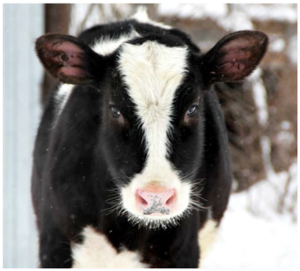Can Calf Barns Really Have Too Much Fresh Air In The Winter?
Click here to view as a pdf: Can Calf Barns Really Have Too Much Fresh Air In The Winter
 By Ryan Leiterman, D.V.M.
By Ryan Leiterman, D.V.M.
Cold temperatures are here and winter is quickly approaching. As the temperatures drop, calf barns are closed up and the ventilation rates are turned down. As an industry we do this reflexively, but is it what’s best for the calves?
Studies show that pre-weaned calves raised in hutches have lower pneumonia rates when compared to calves raised in barns. Even calves raised in calf barns equipped with modern ventilation systems can experience increased respiratory disease rates when compared to their hutch-raised counterparts.
Current calf barn ventilation guidelines suggest that as temperatures cool, the volume of fresh air brought into the barn should decrease. I would like to humbly challenge this assumption. After all, hutch-raised calves have been challenging this concept for years. Hutch calves do not have their volume of fresh air reduced during cold weather. Once outside the hutch, calves have an unlimited volume of fresh air to breathe, regardless of the season. For these reasons, the current recommendation of providing calf barns with four fresh air exchanges per hour, often defined as minimal winter ventilation, should be revisited. 
The fact that hutch-raised calves do not have nose-to-nose contact certainly helps prevent the spread of contagious pneumonia. Yet, the individual pens used in many calf barns also prevent nose-to-nose contact and these calves often have higher pneumonia rates than hutch-raised animals. It seems counterintuitive that hutch-raised calves would have less respiratory disease than their barn-raised counterparts. Hutch-raised calves often experience more heat stress in the summer and colder temperatures in the winter.
During wet spring months, it can be challenging to keep hutch calves dry. In winter, if the wind is blowing into the hutch, calves can be exposed to a dangerous draft. Yet from a respiratory disease standpoint,hutch-raised calves are still healthier than barn-raised calves. Their lower pneumonia rates suggest that having unlimited amounts of fresh, outside air to breathe offsets the environmental hardships hutch-raised calves experience.
“Too Much” Fresh Air?
As a veterinarian working with calf raisers for the past eight Wisconsin winters, I have never had a client say, “Doc, sometimes I worry about my hutch calves having too much fresh air to breathe in the winter.”
There is a belief throughout our industry that if we increase the volume of fresh air brought into a barn, it will be drafty on the calves. This belief stems from decades of experience with negative pressure ventilation systems.
If hutch calves thrive with an unlimited volume of fresh air to breathe in winter, why are we as an industry limiting our calf barns to only four air exchanges per hour during cold weather?
Negative pressure ventilation systems use exhaust fans to suck air through a barn. The classic example of a negative pressure ventilation system is a tunnel-ventilated stanchion barn. Multiple large exhaust fans pull air through the barn and overtop of the animals. As more fans are turned on, the volume of air sucked through the barn increases, subsequently increasing the air speed. With any negative pressure ventilation system, the air speed flowing through the barn is directly related to the volume of air pulled through by the exhaust fans.
In negative pressure ventilation systems, higher airflow volumes result in faster air speeds through the barn. Lower airflow volumes result in slower air speeds through the barn. See Figure 1.

These principles of negative pressure ventilation have created the longstanding association that increasing fresh air volume increases speed. It makes sense, with a negative pressure ventilation system, to reduce the volume of fresh air brought into the barn during cold weather; it’s the only way to avoid a draft on the animals. The principles of negative pressure ventilation, to reduce fresh air volume during cold weather and increase it during warm weather, eventually became the basis of our current calf barn ventilation guidelines. See Table 1.

The current ventilation guidelines have remained unchanged for decades while over the same time-period, ventilation technology has improved dramatically. Today, many calf barns are ventilated using positive pressure tube systems, which do not follow the same engineering principles as negative pressure ventilation systems. Thus, it does not make sense to follow guidelines developed for negative pressure ventilation when designing positive pressure tube systems.
Positive Pressure Tubes Are Different
Positive pressure tube ventilation systems blow fresh, outside air into ductwork, commonly referred to as a tube, to evenly distribute it throughout the barn. The tube has specially designed holes that discharge fresh air out of the tube and into specific areas of the barn.
With negative pressure ventilation, air speed and volume are linked; increasing one increases the other. This is not the case with positive pressure tube ventilation. Air speed at the calf level is not dependent on the volume of air blown into the tube but rather the:
- Distance from the tube to the calf: the longer the air has to travel, the slower it will be when it reaches the calves.
- Diameter of the discharge holes in the tube:
- Small diameter discharge holes produce weak, thready air streams that quickly lose momentum, much like air blown through a small-diameter straw. These weak air streams result in slow, gentle air reaching the calves. Numerous, small diameter holes in a ventilation tube are ideal for cold weather use.
- Large diameter discharge holes in a tube produce robust air streams with more momentum, much like a leaf blower with a large-diameter nozzle. These robust air streams deliver fast, cooling air over longer distances. Fewer, large diameter discharge holes in a ventilation tube are ideal for warm weather use.

What Does The Future Hold?
Our industry has the opportunity to expand the conversation about how we ventilate calf barns. The fact that positive pressure tube ventilation can be used to increase winter ventilation rates beyond four air exchanges per hour brings into question the age-old concept of reducing fresh air volume during cold weather. This technology has exposed the need for new calf barn ventilation guidelines to be developed and implemented; guidelines that promote higher volumes of fresh air exchange during cold weather.
My experience has shown that numerous calf raisers are finding cold weather ventilation success with positive pressure tubes that deliver non-drafty fresh air at exchange rates greater than four times per hour. These calf raisers have learned through experience that limiting the volume of fresh air coming into the barn was not in the best interest of the calves. After all, hutch-raised calves have shown for decades that in the absence of a draft, there is no such thing as “too much” fresh air.
